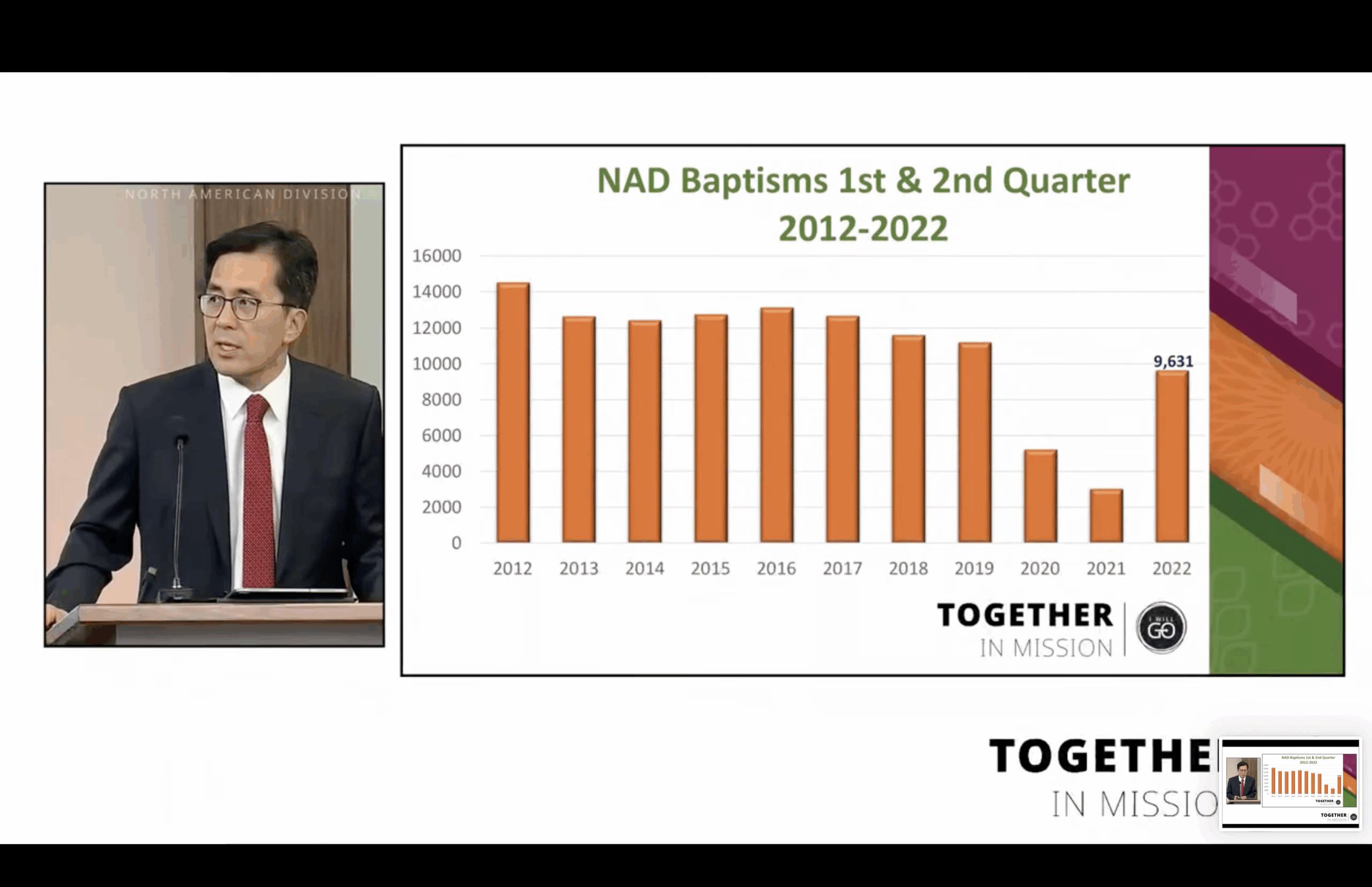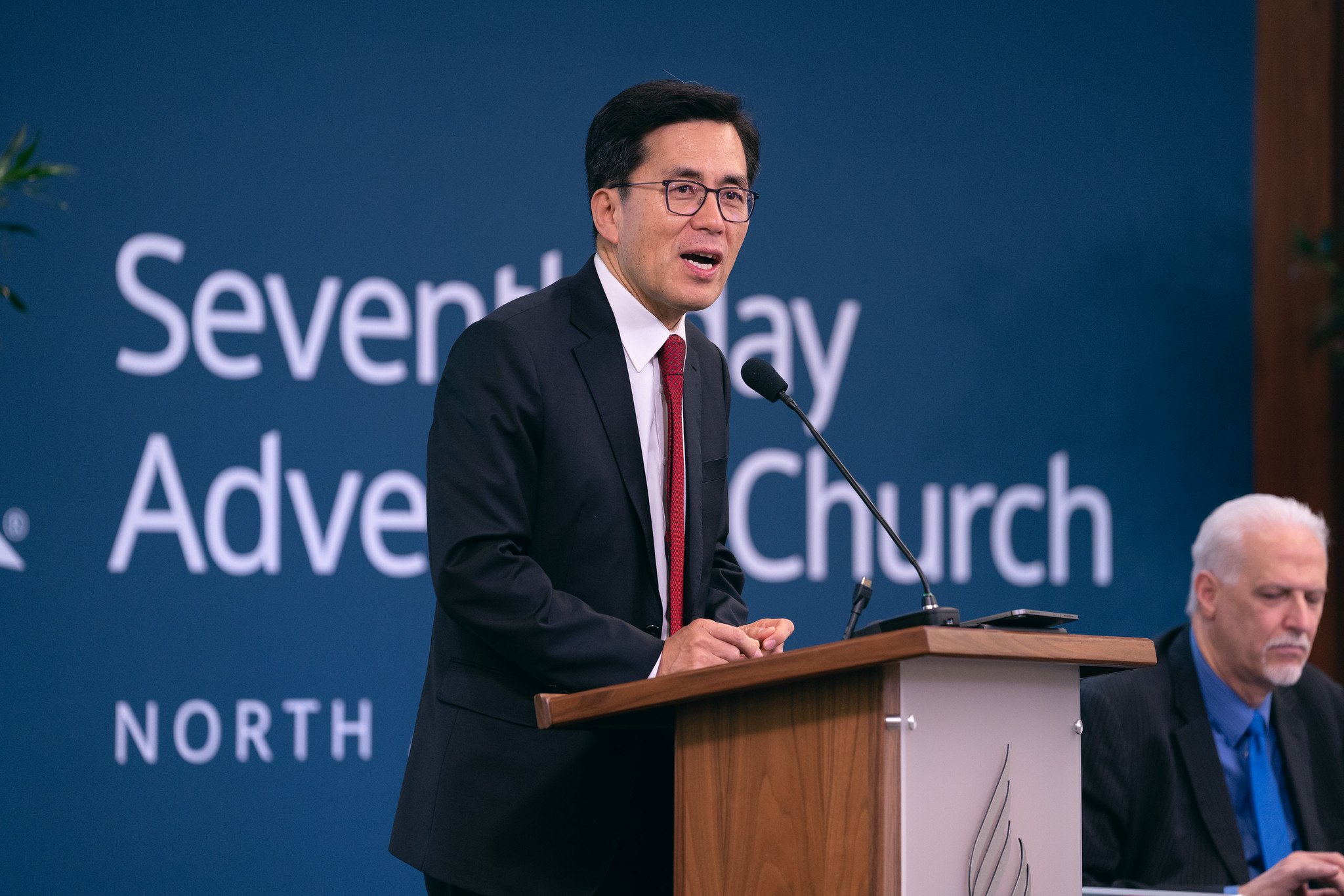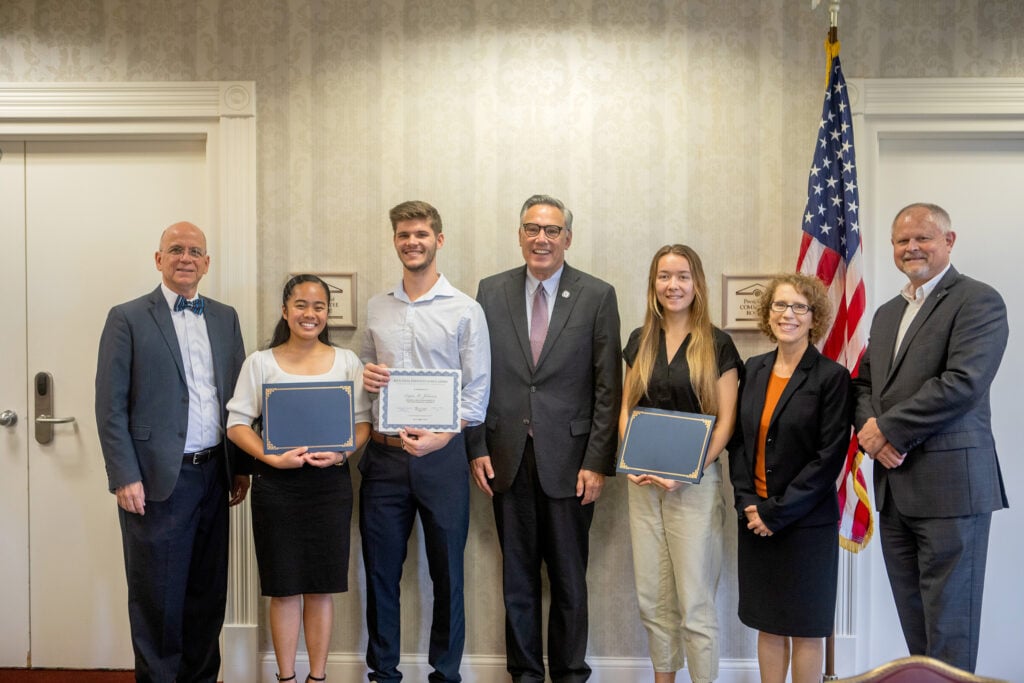On Oct. 27, 2022, day two of the NAD’s Year-End Meeting, executive secretary Kyoshin Ahn and his team built upon president G. Alexander Bryant’s opening presentation by casting a vision for disciple-making in North America via the secretariat.
Ahn and leaders from secretariat ministries, including the Office of Volunteer Ministries, Human Relations, eAdventist Membership Services, Archives, Statistics and Research and Professional Services, offered a comprehensive, optimistic view of the post-pandemic Church.
Uptick in Membership Since 2020
After thanking his team for their contributions, Ahn shared that by December 2021, the NAD had 1,271,642 members worshipping in 5,662 churches and 902 companies. The net membership increase was 5,888.
Resurgence was a recurring theme. “You may notice a steady increase in our division membership. It’s not drastic but is still meaningful considering we were under COVID-19 in 2021,” Ahn said. “Due to the pandemic, we had a drastic decrease in baptisms in 2020 but saw [a] resurgence in this area in 2021. We had [over] 20,000 baptisms in 2021, and we praise God for each and every person baptized.” Also, Ahn reported that baptisms in the first two quarters of 2022 totaled 9,631, close to pre-pandemic numbers and “one more sign that we are bouncing back.”
Furthermore, in 2021, 4,885 members were added by profession of faith, contributing to a total of 25,182 new members. “[New memberships] are down by 10,000 compared to before the pandemic but much, much better than 2020! We want to see the NAD fully bounce back [by] the end of the year.”

Other Key Membership Stats
Among other findings, 47 percent (the majority) of the NAD’s members are between ages 30-59 and 32 percent are 60+. The younger generation is far less represented, with ages 19-29 at 15 percent; 13-18 at 5 percent; and 0-12 at one percent (although children are underrepresented because stats only include baptized members).
Sadly, 10,415 members died in 2021 — 2,000 more than in pre-COVID years, with a total of 4,100 abnormal deaths throughout the pandemic. Ahn added, “Last year, 7,800 people were removed from our membership data due to missing or being dropped. [But] when you tally up the [numbers], we had more gains than losses in 2021.”

Nurture and Retention
Ahn then turned to Bonita J. Shields, associate secretary, who has been spearheading work in nurture and retention, to address the fact, as shared by Ahn earlier in the report, that between 8,000 and 10,000 people are removed from the NAD’s membership data annually.
Shields began, “While most people consider secretaries primarily data people, we believe that every number on a statistical report represents a person, and our mission as spiritual leaders in secretariat is to not only [help] reach God’s people for God’s kingdom but to retain them as well.”
She then shared recommendations arising from recent brainstorming sessions with union and conference secretaries.
These included:
- Training and resourcing executive secretaries to foster a culture of nurture and retention.
- Aligning with other church entities in the work of nurture and retention. Reported Shields: “We have begun collaborating with Ministerial, especially since executive secretaries often serve as evangelism directors. And we will continue to align with other church entities because we are stronger together.”
- Growing God’s kingdom more effectively, encouraging the Church to develop an operating system that more intentionally trains pastors to equip local church members for ministry, rather than encouraging members to assist the pastor in ministry.
“This doesn’t suggest that none of this training is taking place. But it [does suggest] that we should strengthen our system to focus more on growing disciples and disciple-makers, rather than just being content to have church members,” Shields stated.
eAdventist Membership Ministry
Next, Brian Ford, eAdventist membership ministry director, broke down membership statistics by union. In his video report, he first graphically depicted the different unions’ church growth since 2019, revealing that most unions recovered to some degree in 2021 after taking a hit in 2020.
He then reported on church growth as per four ethnic categories — African-American, Hispanic, Anglo/Multi/None, and other. The Anglo/Multi/None category was the largest, followed by African-American. Ford highlighted, “The bulk of the growth in [the NAD’s] baptisms and professions of faith seems to be coming from the Hispanic churches, not in terms of numbers but in proportion to their membership. They are producing more baptisms per member.”
Ford also revealed that in 20 years, eAdventist has become much more than an electronic membership database. For example, its technological tools for churches include a web app that serves as an online bulletin and directory and ways to send mass emails and texts to mailing lists — free!
“By far, the most valuable feature in our messaging lists is text messaging. For instance, we see pastors sending these on Sabbath morning, a quick reminder that the service is starting, [with] a YouTube link. And we’re on track to deliver a million text messages this year.”
Office of Volunteer Ministries
Next, the Office of Volunteer Ministries (OVM) director, Ernest Hernandez, revealed, “Our office is at the crossroads of a new beginning.” He stated that OVM is excited that both short- and long-term missions are returning to normal, with more than 4,000 participants on 260 mission trips and almost 500 serving or soon deploying for long-term missions.
He mentioned, “As we launch a new beginning, we want to reaffirm why OVM was created in 1995 under Jose Rojas’s leadership. It [arose from] a need to form an agency [bringing] together a vision for volunteerism, networking many organizations and departments into a focused and standardized set of principles, unified insurance, mitigation of risk, and increased mobility. In keeping with that vision, today, OVM collaborates with NAD departments, with the General Conference AVS* global network, universities, conferences, and centers of influence.”
Hernandez noted OVM’s shift in focus. “Historically, the OVM deploys 85 percent into the foreign mission field. [Given] increased challenges in our inner cities, poverty, violence, [and] immigration and refugee needs, our division has become a mission field. Our [future] efforts will include a focus inside our division, with a three-year goal of engaging up to 1,500 missionaries. We have a prophetic mission to fulfill, and it is to see missionaries serving in our backyard.”

Office of Human Relations
Carolyn Forrest, associate secretary and director of Human Relations, then shared that her office continues to build on “valuing our differences through diversity, equity, and inclusion.” One of their focuses is also “ongoing revival. For it is on our knees that we’ll go forward.”
Coming out of a March advisory, it was decided to recommend a new working policy for background checks for new hires, transfers, or rehires.
Forrest, whose portfolio also includes women in ministry and intra-denominational mission, celebrated the approval of two women pastors through the Women in Ministry Scholarship program in 2021 and three in 2022, with five in the process, as well as the recent placement of three missionary families in Guam/Micronesia, one of the NAD’s farthest-flung territories.
Office of Archives, Research & Statistics
Next, attendees learned about the recently-formed office of Archives, Research & Statistics, and welcomed Michael Campbell, a seasoned archivist and researcher, who started at the NAD in July.
Campbell mentioned recent discoveries such as “records giving context to early Adventism, including Ellen White’s financial records” this summer among archives around the Rural Health Retreat of Healdsburg College; and materials including the Sabbath Recorder, used by J. N. Andrews, which he found when Siri led him to a Camp Wakonda run by Seventh-day Baptists rather than the Adventist-run Wakonda in Wisconsin.
Among Campbell’s goals are to implement an Adventist oral history program and digitize Adventist records. “Part of my dream for [this department] is that it will be a clearinghouse for the very best research taking place in and about Adventism, like an Adventist Barna Group.”
He concluded, “This department pledges to do our best to cultivate opportunities to better understand Adventism, both past and present, so that we can all become better equipped to fulfill our mission of sharing what we believe in fresh and relevant ways.”
Department of Professional Services
“The heart of what we do is service. We support the departments and services of the North American Division in the development of relevant and effective resources for their target audience. We do this through project management, graphic design, web design, social media, marketing strategies, and aspects of multimedia,” said the next presenter, Rohann Wellington, director of Professional Services.
The newly-created department offers consistency and cost-effective creative support to departments across the NAD. Angeline Brauer, Health Ministries director, and a customer, said enthusiastically, “Health Ministries has been incredibly blessed to work with Professional Services this past year. They have done everything for us from designing simple graphics for social media to an eight-booth-wide display at the CALLED Pastors’ Family convention. We love having them as part of our team. And we couldn’t do this without them.”
Wellington concluded, “Our vision is to help the NAD’s departments clearly and beautifully communicate God’s message of hope and wholeness as we leverage combined resources. Their success is our success.”
COVID-19 Report
Ahn’s report concluded with results of research the NAD COVID-19 task force he led commissioned on members’ understanding and perception of the COVID-19 vaccination. He acknowledged that he wasn’t sure he should tackle such a sensitive topic. “I don’t like controversy, and I like to live a peaceful life,” he said, chuckling as others also laughed.
Despite his misgivings, he realized, since the last pandemic was 100 years prior and there was no data on the church’s perspective, “we couldn’t let this opportunity slip by.”
He continued, “I want to assure you that this [study] was never intended to highlight one group or position over the other. [Rather], we wanted to capture the perspective of North American Adventists in this era and leave a historical record [for] the next generation of North American Adventists to reflect upon in their own context and figure out how to serve the church better.”
Dr. Petr Činčala, director of the Institute of Church Ministry at Andrews University, summarized the study titled, “‘Are you pro or against the COVID-19 vaccination?’: A Closer Look at North American Division Members’ Attitudes,” conducted by Činčala, Injae Son, and Brauer.
Among the results:
- The North Pacific Union Conference was the most vaccinated (21.6 percent) and the Pacific Union Conference the least vaccinated (83.8 percent)
- Members from churches of 50 or less were less likely to be vaccinated (61.1 percent) versus members from churches of 401 and more (85.7 percent)
- 54.4 percent of those with very conservative religious views were vaccinated versus 93.8 percent of those with very liberal religious views
- The youngest respondents, 18-44, were the least vaccinated (58.8 percent), and the oldest, 65+, were the most vaccinated (76.2 percent)
- Politically, 85 percent of Liberals were vaccinated compared to 58.3percent of Conservatives
- Seventy-eight percent of those from the inner city/metropolitan areas were vaccinated versus 47.9 percent of those from rural areas
- 67.5 percent of the unvaccinated were very unlikely to get the vaccine in the future.
Specific to the GC guidance on immunizations, 25.9 percent of all surveyed said they were very familiar with it, while 37 percent said they were not familiar with it at all. Finally, participants’ recommendations included providing accurate information (39.2 percent) and respecting freedom of choice (24.6 percent).
“May Christ’s Love Move Us to Such Extremes”
As he concluded the secretary’s report, Ahn referred to the early church. “They were small in size and didn’t have many organizational resources. How was it possible that for [them] to move forward and ultimately change the course of history?”
“The answer is in 2 Corinthians 5:14 (The Message Bible): “Christ’s love has moved me to such extreme. His love has the first and last word in everything [I do and] we do,” Ahn continued.
“May Christ’s love [unite us] and move us to such extremes. May that fantastic reality be ours. And that is my report, Mr. President,” he said to amens and applause.
*Adventist Volunteer Services
[Click here for more news coverage of the 2022 North American Division Year-End Meeting.]




